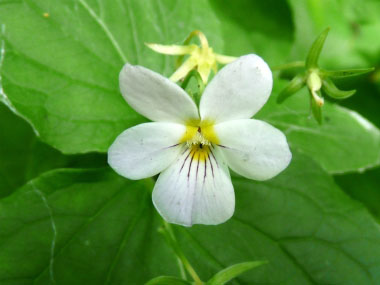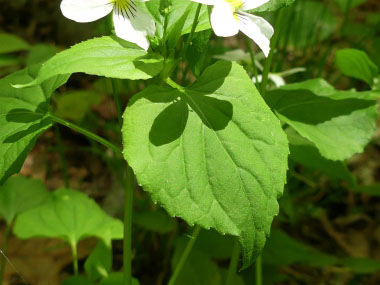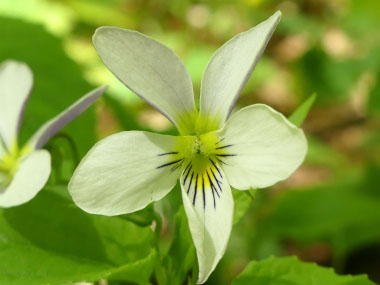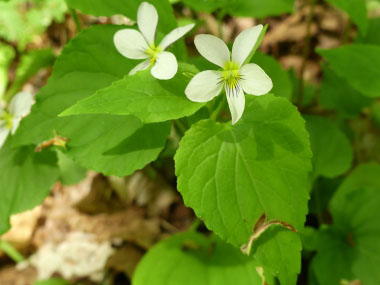






To support our efforts please browse our store (books with health benefits, etc.).
Canadian white violets are a tall, leafy-stemmed perennial. In some geographical locations, this plant is considered an endangered wildflower. Check with local resources; if you are in an area in which this plant does not grow in abundance, do not forage. In the Violaceae (violet) family, this perennial plant grows from a short rhizome with fibrous roots, forming clumps, and it spreads by stolons. This is a plant that tends to grow in abundance in hardwood forests (beech-birch-maple or maple-basswood-ash type), usually with sugar maple as a dominant species.
Distinguishing Features
These white violet flowers, sometimes tinged with purple, have striking yellow centres. The fragrant flowers hang and face outward at tips of short, slender, purplish stalks that grow from axils of heart-shaped, fine-toothed leaves. Leaves are long-petioled, heart-shaped, and deep-green.
Flowers
Single flowers on naked stalks arise from the leaf axils. Flowers are about 3 cm (1”) across, slightly irregular with 5 white petals. It is distinctly yellow at the base, and dark purple lines on the lower petals. The side petals are bearded with tufts of short hairs. The backs of the petals are tinged purple. Flowers bloom between April and June.
 Fields
of Nutrition has medicinal benefits and vitamin/mineral content of Canadian White Violet.
Fields
of Nutrition has medicinal benefits and vitamin/mineral content of Canadian White Violet.
Leaves
There are both basal and stem leaves, most are heart-shaped, 5 to 10 cm (2 to 4”) long and up to 8 cm (3”) wide, with scalloped or shallowly toothed edges and sharply pointed tips. The stem leaves are typically more elongated than basal leaves. There are fine hairs on leaf edges and along major veins on the underside.
Height
This plant grows between 20 and 40 cm (8 to 16”) tall. Stems are hairless or they have a few scattered hairs, green, and often tinged purple.
Habitat
Canada white violet prefers rich, moist soils and it can be found in moist ravine areas. The Canada violet is normally found in healthy woodlands, although escaped cultivated plants are likely to appear in more disturbed areas. This violet prefers dappled sunlight to light shade during the spring, but tolerates greater shade during the summer.
Edible Parts
Young leaves and flower buds are edible raw or cooked. A mild flavour, when boiled as greens they are best mixed with other stronger tasting leaves. When added to soup they thicken it in much the same way as okra. Flowers can be eaten raw.
Other Name
Canada Violet.
Similar Plants
Winter Survival Food Handbook

PDF Plant Magazines
Types of Wild Food
Geographic Zones Seasons
Disclaimer
EdibleWildFood.com is informational in nature. While we strive to be 100% accurate, it is solely up to the reader to ensure proper plant identification. Some wild plants are poisonous or can have serious adverse health effects.
We are not health professionals, medical doctors, nor are we nutritionists. It is up to the reader to verify nutritional information and health benefits with qualified professionals for all edible plants listed in this web site. Please click here for more information.
Why Edible Wild Food?
- Food costs are rising
- Free, wild food is readily abundant
- Wild food adds nutrition to your diet
- Wild food can help treat various medical conditions





